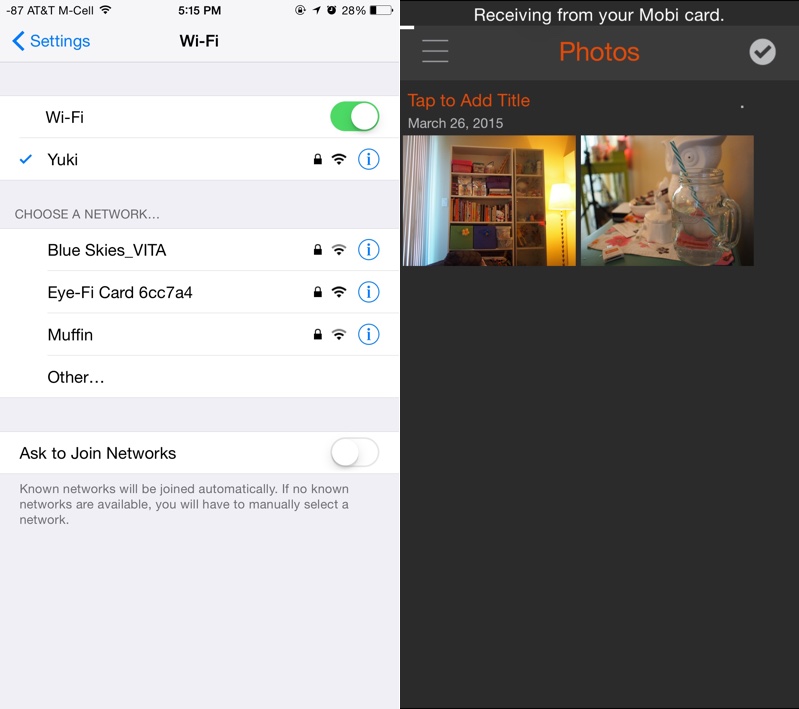
#Eye fi password plus#
It’s not ideal for security and principal of least privilege, however it works so that’s a plus I guess.
#Eye fi password windows#
I have now resorted to the the idea and am running the account using the Local Administrator account which is the account you use to login to the Windows Home Server Console for management purposes. Using Process Explorer and comparing the results (specifically the TCP/IP Stack) of the Eye-Fi Manager.exe process when it was running as a local user and the NetworkService account showed that the NetworkService service version didn’t open up the required TCP Listening ports.Īt this point, I created a service account called svcEyeFi and used that account to launch the service, however this has the same results as the NetworkService account even after adding the account to the Local Administrators group. Unfortunately this still didn’t solve the problem. * The reason I upload to the Public folder is that I like to rename, tag and adjust all my pictures before allowing them into the Photos shared folder. I assumed it was NTFS permissions now, so I added the NetworkService account to the RW_7 group on the Home Server, which is the group created by Windows Home Server for permitting Read and Write access to the Public folder*. The following reg command performs this for me: reg add HKLMSYSTEMCurrentControlSetServicesEyeFiManager /v ObjectName /t REG_SZ /d "NT AUTHORITYNetworkService"Īfter restarting the service, I still couldn’t upload the photos. I decided to change thhe service to use the NetworkService account as this would allow it access to the network. Ing to the default account used by servcies which is the System account. I immeadiatly assumed the problem was the permissions relat reg add HKLMSYSTEMCurrentControlSetServicesEyeFiManagerParameters /v Application /t REG_SZ /d "C:Program FilesEye-FiEye-Fi Manager.exe" Although the application was running it wasn’t processing any uploads. I proceeded to test it and unfortunately I noticed a problem. Starting the EyeFiManager service I created that launches srvany.exe will now start the Eyei-Fi Manager.exe application and it will run as required, with the exception that none of the user interaction such as thumbnail previews of the uploading pictures can be seen as it’s a background service. Reg add HKLMSYSTEMCurrentControlSetServicesEyeFiManagerParameters /v Application /t REG_SZ /d "C:Program FilesEye-FiEye-Fi Manager.exe"

This is done easily using the reg command line tool as follows: Once this is done, you need to instruct srvany the name of the executable you want it to handle. To this end, the command becomes the following: sc create EyeFiManager DisplayName= “Eye-Fi Manager†start= auto binPath= “C:WINDOWSSystem32srvany.exe†In my example, I placed the executable in the System32 directory so that I can call it without declaring the path to the application and without having to add custom strings to the Path environment variable.
#Eye fi password download#
I’ve put a copy of the executable srvany.exe on my Windows Live SkyDrive for you to download for your own uses. The result is that srvany handles the service and responds to Windows as required. srvany.exe is the service executable and you provide your executable as a parameter for srvany. Microsoft produced a utility for NT4 called srvany.exe which still works in Windows versions today. Unfortunately when I tried to start the service, Process Explorer showed me the Eye-Fi Manager.exe application as running however after a few seconds it terminated and the Services MMC console gave the error that the application didn’t respond in a timely fashion, so the application is obviously not designed to be a service, I therefore needed a middle man. sc create EyeFiManager DisplayName= “Eye-Fi Manager†start= auto binPath= “C:Program FilesEye-FiEye-Fi Manager.exe†The following command should as done the trick. The Service Command (sc.exe) application makes this real easy for me to do. I looked at the forums for Eye-Fi and their website and there is a thread on the forum for exactly the same thing – Configuring Eye-Fi Manager as a service, however it doesn’t actually go into any details so I had to figure it out for myself. Solving the problem requires it to be running as a service. Because I am connected to the Windows Home Server via Remote Desktop I logoff the server once I’m finished and the application shuts down. The application is executed by the currently logged on user and not as a service.

After configuring my Eye-Fi Manager appliction on the Windows Home Server, I quickly noticed a problem.


 0 kommentar(er)
0 kommentar(er)
